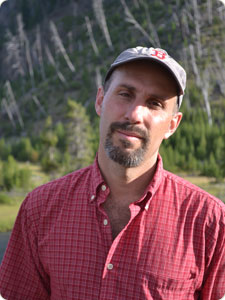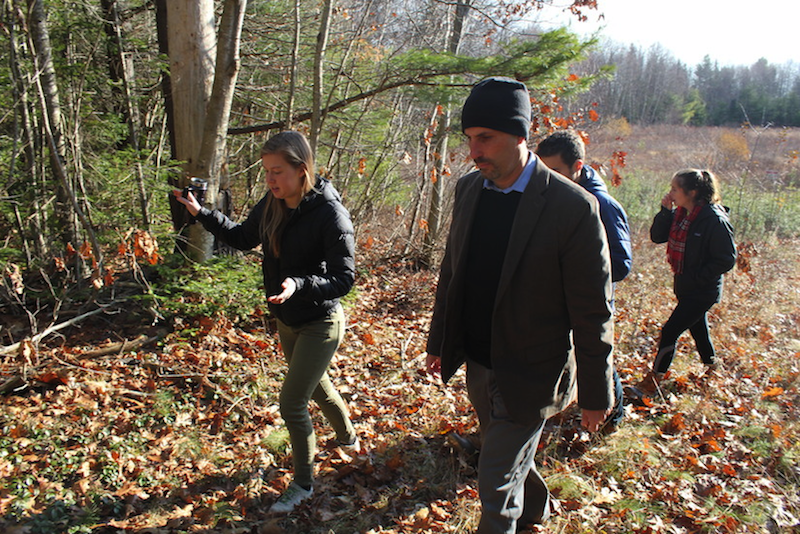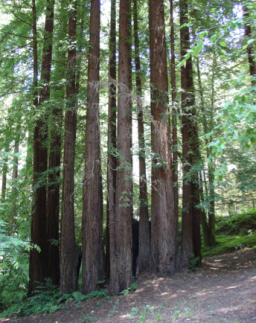The Evolutionary Benefits of Cloning, According to Bowdoin Ecologist
By Rebecca Goldfine
To draw in crowds to his lectures, Assistant Professor of Biology Vlad Douhovnikoff jokes that he sometimes call his talks, “Why Sex is Overrated.” The ecologist focuses his research on plants (particularly trees) that don’t often sexually reproduce. Instead, the plants tend to produce clones, or genetic copies of themselves.
Douhovnikoff is researching the ecological benefits of cloning, as well as the evolutionary benefits. The latter might at first blush sound contradictory. If an aspen or redwood clone was truly identical to its parent, the trees would lack genetic diversity and so be evolutionarily disadvantaged. But in fact clones can be quite different from their parents.
This phenomenon is partly explained by epigenetics, which looks at how environmental factors alter gene expression. The study of epigenetics is growing quickly as more researchers accumulate evidence showing that the expression of DNA is fluid and variable, and that changes in how a cell reads genes can be inherited.
In essence, scientists are finding that the ways animals and plants respond to events in their lifetimes can have lasting effects on their cells — and also affect the genetic material they pass on to offspring. “Your experiences can be recorded in a way that is permanent enough to make it across the reproductive jump into the next generation,” Douhovnikoff said. “We’ve seen this across multiple generations.”
Cloning advantages
Before getting into the nuances of epigenetics, Douhovnikoff explains why plants resort to cloning when sexual reproduction is so successful in creating species well suited to their environments.
One explanation is that when a tree creates clones, and that clone creates clones, the trees in time can develop a large interconnected system that is able to share resources. “Instead of working individually, they can divide the labor,” Douhovnikoff said. If some of the clones have roots in water, they can pump the water into the larger system. Other trees might be at the top of a hill where it is dry but sunny. They in turn can send their photosynthetic materials (carbohydrates) to the others.
Through this coordination, clonal families “come up with the optimal solution to whatever environment they’re dealing with,” Douhovnikoff said. It’s thought that more than a majority of seed producing plants have the capacity to clone, although it’s unclear how frequently plants clone versus sexually reproduce. Clonal trees will typically wait for optimal conditions — such as warm temperatures and adequate rainfall — to reproduce sexually. After all, fragile seedlings must survive on their own without the parental nursing that clones receive.

For these reasons, many trees probably clone more often than they reproduce sexually. Yet cloning appears to have a serious drawback: a reduced rate of adaptation. “We have seen all kinds of designs in the environment, and they’ve all been the result of natural selection. So how is it that clonal plants are so successful and we see it so much?” Douhovnikoff asked.
Douhovnikoff has been able to dig into this mystery in the last couple of decades as more sophisticated genetic tests have become available. By studying clonal tree genomes, he can map out histories of the species he studies — mostly redwoods, aspens and willow trees, as well as phragmites grasses.
And he has made the remarkable discovery that clonal plants are indeed adjusting to their environment. They are achieving this through epigenetics, which means they are switching on or off certain genes in response to external stimuli, and then passing these learned responses to their clones. “Those responses are not a one-off. It’s not short-term,” Douhovnikoff said. “Even though you started with the same genotype, depending on what combination of genes you’re using or activating, the result is a different epigenotype. So there is a level of diversity that is available now even though there is no genetic diversity.”
Epigenetics may explain the extraordinary adaptability of some invasive species. Phragmites, a marsh reed introduced from Europe more than a century ago, is wreaking havoc on marshes across the United States.Yet phragmites didn’t become a problem until just about 50 years ago, when its population exploded, nudging out native plants and drying out wetlands. (The lightweight grass was originally used as a packing material by shippers. After merchants opened the crates, they discarded phragmites into wetlands behind ports, where the plant took hold.)
“There is some thought that phragmites has figured out through this epigenetic trial and error the model that works,” Douhovnikoff said. “Plants will try out different epigenotypes, and those epigenotypes will result in an optimal phenotype (or observable traits).”
Climate Change: The Future of Clonal Plants

Douhovnikoff recently received a three-year grant from Save the Redwoods League to research epigenotypes of redwood trees. The organization is interested in finding out whether redwoods’ reproductive strategies and epigenetic variation might protect the species from climate change. Redwoods are restricted to a narrow ecosystem along the California coast called the fog belt, where they derive some of their water from the frequent mists that shroud the area. Conservationists are worried that climate change could disrupt the atmospheric conditions that cause the fog, leading to a die-off of the rare trees.
While the redwoods’ fate is uncertain, climate change might not be a death sentence for other clonal plants, according to Douhovnikoff. “If we stick to the original idea that clonal plants aren’t very flexible and they’re not going through adaptation, then one would think clonal plants might be a dead end in a rapidly changing environment,” he said.
Instead, with climate change’s warming conditions, more clonal plants might begin to sexually reproduce and in this way adapt to a different world. Already in the Arctic, where conditions are typically so severe that plants usually resort to clonal reproduction, increasing numbers of species are reproducing sexually as warming temperatures make life more hospitable for seedlings.
On the other hand, in the southern reaches of species’ ranges where it will likely become hotter and drier, Douhovnikoff expects to see more trees turn to epigenetically assisted clonal reproduction. “That envelope will be closing and there won’t be opportunities for seed reproduction,” he said. “That is when cloning will become essential in order to keep on keeping on.”



